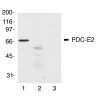Bcl-2-dependent oxidation of pyruvate dehydrogenase-E2, a primary biliary cirrhosis autoantigen, during apoptosis
- PMID: 11457875
- PMCID: PMC203018
- DOI: 10.1172/JCI10716
Bcl-2-dependent oxidation of pyruvate dehydrogenase-E2, a primary biliary cirrhosis autoantigen, during apoptosis
Abstract
The close association between autoantibodies against pyruvate dehydrogenase-E2 (PDC-E2), a ubiquitous mitochondrial protein, and primary biliary cirrhosis (PBC) is unexplained. Many autoantigens are selectively modified during apoptosis, which has focused attention on apoptotic cells as a potential source of "neo-antigens" responsible for activating autoreactive lymphocytes. Since increased apoptosis of bile duct epithelial cells (cholangiocytes) is evident in patients with PBC, we evaluated the effect of apoptosis on PDC-E2. Autoantibody recognition of PDC-E2 by immunofluorescence persisted in apoptotic cholangiocytes and appeared unchanged by immunoblot analysis. PDC-E2 was neither cleaved by caspases nor concentrated into surface blebs in apoptotic cells. In other cell types, autoantibody recognition of PDC-E2, as assessed by immunofluorescence, was abrogated after apoptosis, although expression levels of PDC-E2 appeared unchanged when examined by immunoblot analysis. Both overexpression of Bcl-2 and depletion of glutathione before inducing apoptosis prevented this loss of autoantibody recognition, suggesting that glutathiolation, rather than degradation or loss, of PDC-E2 was responsible for the loss of immunofluorescence signal. We postulate that apoptotic cholangiocytes, unlike other apoptotic cell types, are a potential source of immunogenic PDC-E2 in patients with PBC.
Figures








Comment in
-
Cholangiocytes and primary biliary cirrhosis: prediction and predication.J Clin Invest. 2001 Jul;108(2):187-8. doi: 10.1172/JCI13583. J Clin Invest. 2001. PMID: 11457871 Free PMC article. No abstract available.
References
-
- Kaplan MM. Primary biliary cirrhosis. N Engl J Med. 1996;335:1570–1580. - PubMed
-
- Culp KS, Fleming CR, Duffy J, Baldus WP, Dickson ER. Autoimmune associations in primary biliary cirrhosis. Mayo Clin Proc. 1982;57:365–370. - PubMed
-
- Poupon RE, et al. Combined analysis of randomized controlled trials of ursodeoxycholic acid in primary biliary cirrhosis. Gastroenterology. 1997;113:884–890. - PubMed
-
- Angulo P, et al. Long-term ursodeoxycholic acid delays histological progression in primary biliary cirrhosis. Hepatology. 1999;29:644–647. - PubMed
-
- Pares A, et al. Long-term effects of ursodeoxycholic acid in primary biliary cirrhosis: results of a double-blind controlled multicentric trial. UDCA- Cooperative Group from the Spanish Association for the Study of the Liver. J Hepatol. 2000;32:561–566. - PubMed

